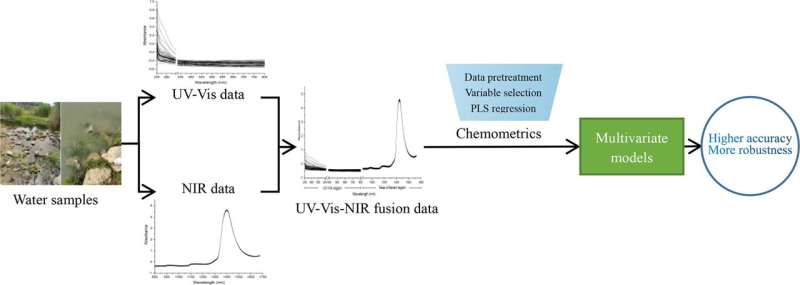This article has been reviewed according to Science X's editorial process and policies. Editors have highlighted the following attributes while ensuring the content's credibility:
fact-checked
trusted source
proofread
Multi-sensor fusion models enable fast and accurate detection of surface water quality

A research team at the Hefei Institutes of Physical Science of the Chinese Academy of Sciences has proposed a new strategy for rapid and accurate detection of surface water quality by fusing the data from the ultraviolet-visible spectra (UV-Vis) and near-infrared (NIR) spectra of surface water.
The study, published in Spectrochimica Acta Part A: Molecular and Biomolecular Spectroscopy, aims to enable real-time monitoring of water quality parameters, which is crucial for the prevention and control of surface water pollution.
Chemical oxygen demand (COD), ammonia nitrogen (AN) and total nitrogen (TN) are key indicators used to assess the extent of surface water pollution. Compared to traditional chemical detection methods, UV-Vis and NIR spectra provide fast, simple, and multi-component analysis techniques that have significant advantages in water quality monitoring.
To improve the accuracy of spectral methods for water quality detection, the researchers developed a detection strategy by fusing UV-Vis and NIR spectral data (UV-Vis-NIR). They collected spectral data and performed chemical determinations on 70 river samples with varying degrees of contamination.
By combining UV-Vis and NIR spectra and using different variable selection algorithms, they optimized the UV-Vis-NIR fusion models for surface water pollution indicators.
The results showed that the UV-Vis-NIR data fusion strategy significantly improved the spectral prediction accuracy of COD, AN, and TN in surface water compared to using a single spectral technique.
Furthermore, this method showed better stability under different optimization conditions, ensuring more robust detection results than those obtained with single spectroscopic techniques.
This study provides an exciting perspective for the future application of online spectral monitoring technology for water quality assessment.
More information: Zhuopin Xu et al, Data fusion strategy based on ultraviolet–visible spectra and near-infrared spectra for simultaneous and accurate determination of key parameters in surface water, Spectrochimica Acta Part A: Molecular and Biomolecular Spectroscopy (2023). DOI: 10.1016/j.saa.2023.123007
Provided by Chinese Academy of Sciences





















